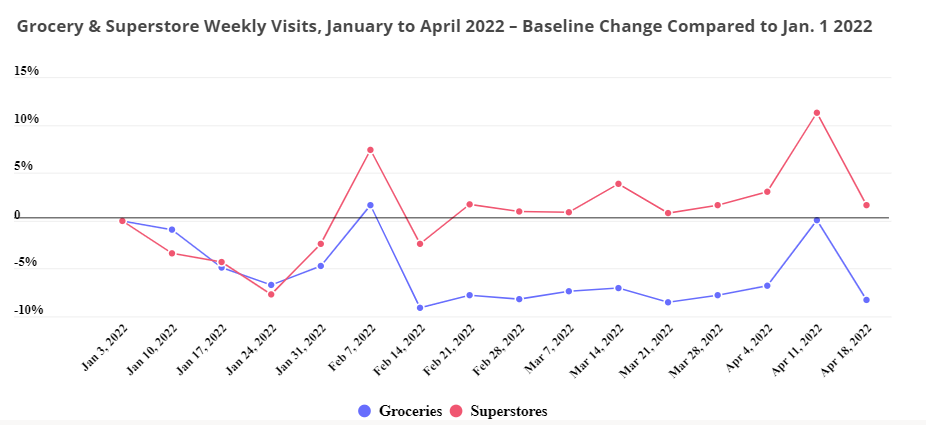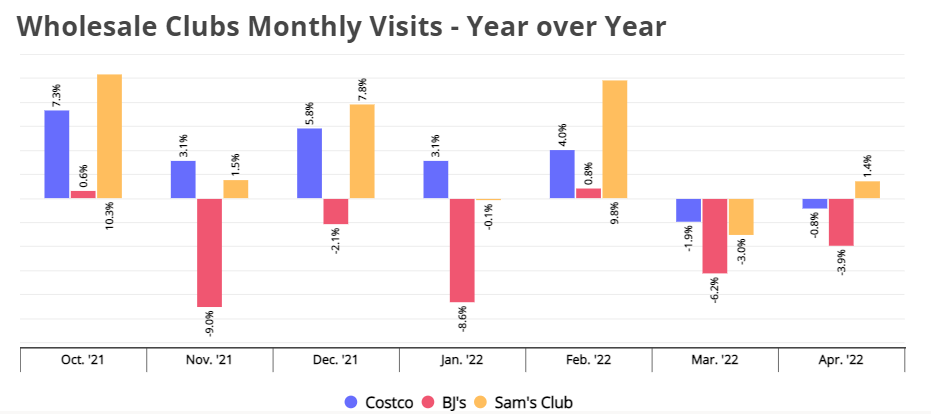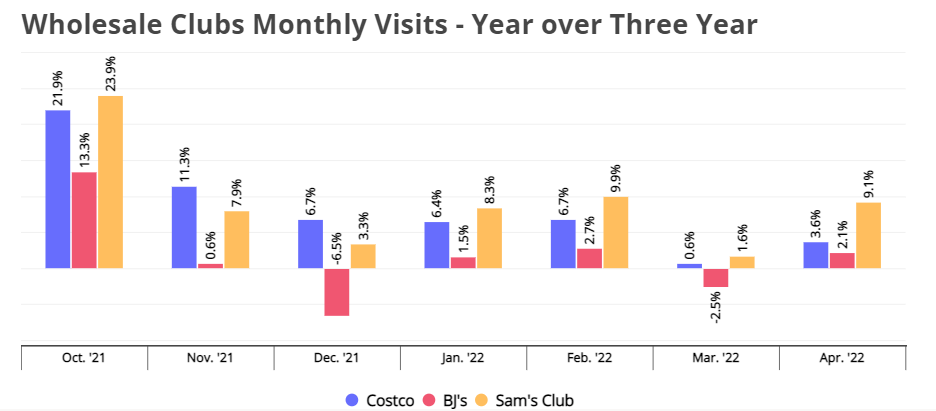
The wholesale category was thriving when we last checked in. Costco landed on our 2022 Predicted Winners list and BJ’s and Sam’s Club were still riding the wave of 2021 success. But the end of 2021 and beginning of 2022 brought about a new set of challenges that threatened to upend the consistent strength the segment had seen.
We dove deeper into the retail foot traffic trends to see how these chains are doing.
Superstores Overtaking Grocery
Since the beginning of 2022, many retail categories found themselves shaken up as the impact of inflation and rising gas prices took hold. Grocery stores, long considered a pandemic “winner” with their ever-increasing visits, began to see foot traffic slipping as consumers turned to superstores to save money by either stocking up or limiting visits.
In Q1 2022, superstores – including Costco, Sam’s Club, and BJ’s, among others – began to outperform grocery nationwide. These trends were likely buoyed by the one-stop-shopping experience superstores offer, which helps cost-conscious customers save on gas and buy in bulk, all while taking advantage of the value orientation of these chains.

The Yearly Picture
Diving deeper into the wholesale club sector specifically, the segment’s leaders – and BJ’s in particular – experienced dramatic foot traffic surges over the pandemic. Yet, year-over-year (YoY) declines in early 2022 indicate that the category could be facing greater headwinds. All three chains analyzed saw months in 2022 where visits declined compared to the same months a year prior. Whether due to Omicron, inflation or gas prices, the unique mix of challenges clearly impacted the sector’s performance.
However, it’s important to consider the context of these year-over-year numbers; it compares traffic during a period of unique challenges for visits in 2022 to one of unique success from 2021. These declines here need to be understood within the wholesale club context, where less frequent visits were consistently offset by larger basket sizes throughout the pandemic. This ability to thrive even as visits decline is an important feature that has enabled the segment to over perform throughout the pandemic. And this likely worked in favor of these chains in recent months, especially considering how quickly they rebounded from more difficult months.

Sustained Year over Three Year Growth
But even more context comes from zooming out in time and looking at visits compared to the equivalent months pre-pandemic. While year-over-year numbers compare a current period of significant challenges to a period of unique strength, looking back at pre-pandemic visits shows just how far the segment, and its top chains, have come. April visits to BJ’s, Sam’s Club, and Costco were up 2.1%, 9.1%, and 3.6%, respectively, when compared to April 2019 – even in the face of inflation and rising gas prices.
Even BJ’s, the sole retailer to see occasional negative monthly numbers from this perspective, quickly returned to growth after each decline. After a March dip of 2.5%, it quickly rebounded into 2.1% growth in April when compared to the equivalent month in 2019.
And although they may not have matched the levels seen in 2021’s wholesale club-surge, the wholesaler has even more reason to be optimistic. The chain, which has roughly one-third the amount of stores as their direct competitors, is embracing innovation as a way to attract customers. Its recently launched BJ’s Market acts as a local grocer, combining wholesale prices (and membership dues/benefits) with more typical city supermarket offerings. The ability to leverage its current strength as a platform to launch new offerings is a key signal that the brand is looking to maximize the boost it has seen in recent years.

Takeaways
2022 presented a unique mix of challenges and even a high-performing sector like wholesale clubs was not immune. However, context is critical. While year-over-year visits declined in some cases, the segment’s leap forward is obvious when comparing visits to the same months pre-pandemic. In addition, these retailers have proven particularly adept at serving customers whether they choose more regular visits, or look to bulk up on less frequent stops.
Should the wider economic headwinds continue to dissipate, the sector could be poised for another period of positive traffic trends. But even if these elements continue to impact shopping patterns, the value orientation these chains provide and their ability to mesh with mission-driven shopping should drive continued relative strength.
To learn more about the data behind this article and what Placer has to offer, visit https://www.placer.ai/.







Sign up to receive our stories in your inbox.
Data is changing the speed of business. Investors, Corporations, and Governments are buying new, differentiated data to gain visibility make better decisions. Don't fall behind. Let us help.













Sign up to receive our stories in your inbox.
Data is changing the speed of business. Investors, Corporations, and Governments are buying new, differentiated data to gain visibility make better decisions. Don't fall behind. Let us help.





